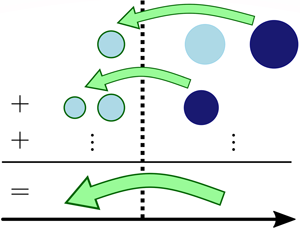Article contents
The turbulent bubble break-up cascade. Part 1. Theoretical developments
Published online by Cambridge University Press: 15 February 2021
Abstract

Breaking waves entrain gas beneath the surface. The wave-breaking process energizes turbulent fluctuations that break bubbles in quick succession to generate a wide range of bubble sizes. Understanding this generation mechanism paves the way towards the development of predictive models for large-scale maritime and climate simulations. Garrett et al. (J. Phys. Oceanogr., vol. 30, 2000, pp. 2163–2171) suggested that super-Hinze-scale turbulent break-up transfers entrained gas from large- to small-bubble sizes in the manner of a cascade. We provide a theoretical basis for this bubble-mass cascade by appealing to how energy is transferred from large to small scales in the energy cascade central to single-phase turbulence theories. A bubble break-up cascade requires that break-up events predominantly transfer bubble mass from a certain bubble size to a slightly smaller size on average. This property is called locality. In this paper, we analytically quantify locality by extending the population balance equation in conservative form to derive the bubble-mass-transfer rate from large to small sizes. Using our proposed measures of locality, we show that scalings relevant to turbulent bubbly flows, including those postulated by Garrett et al. (J. Phys. Oceanogr., vol. 30, 2000, pp. 2163–2171) and observed in breaking-wave experiments and simulations, are consistent with a strongly local transfer rate, where the influence of non-local contributions decays in a power-law fashion. These theoretical predictions are confirmed using numerical simulations in Part 2 (Chan et al., J. Fluid. Mech. vol. 912, 2021, A43), revealing key physical aspects of the bubble break-up cascade phenomenology. Locality supports the universality of turbulent small-bubble break-up, which simplifies the development of cascade-based subgrid-scale models to predict oceanic small-bubble statistics of practical importance.
- Type
- JFM Papers
- Information
- Copyright
- © The Author(s), 2021. Published by Cambridge University Press
References
REFERENCES
- 25
- Cited by



